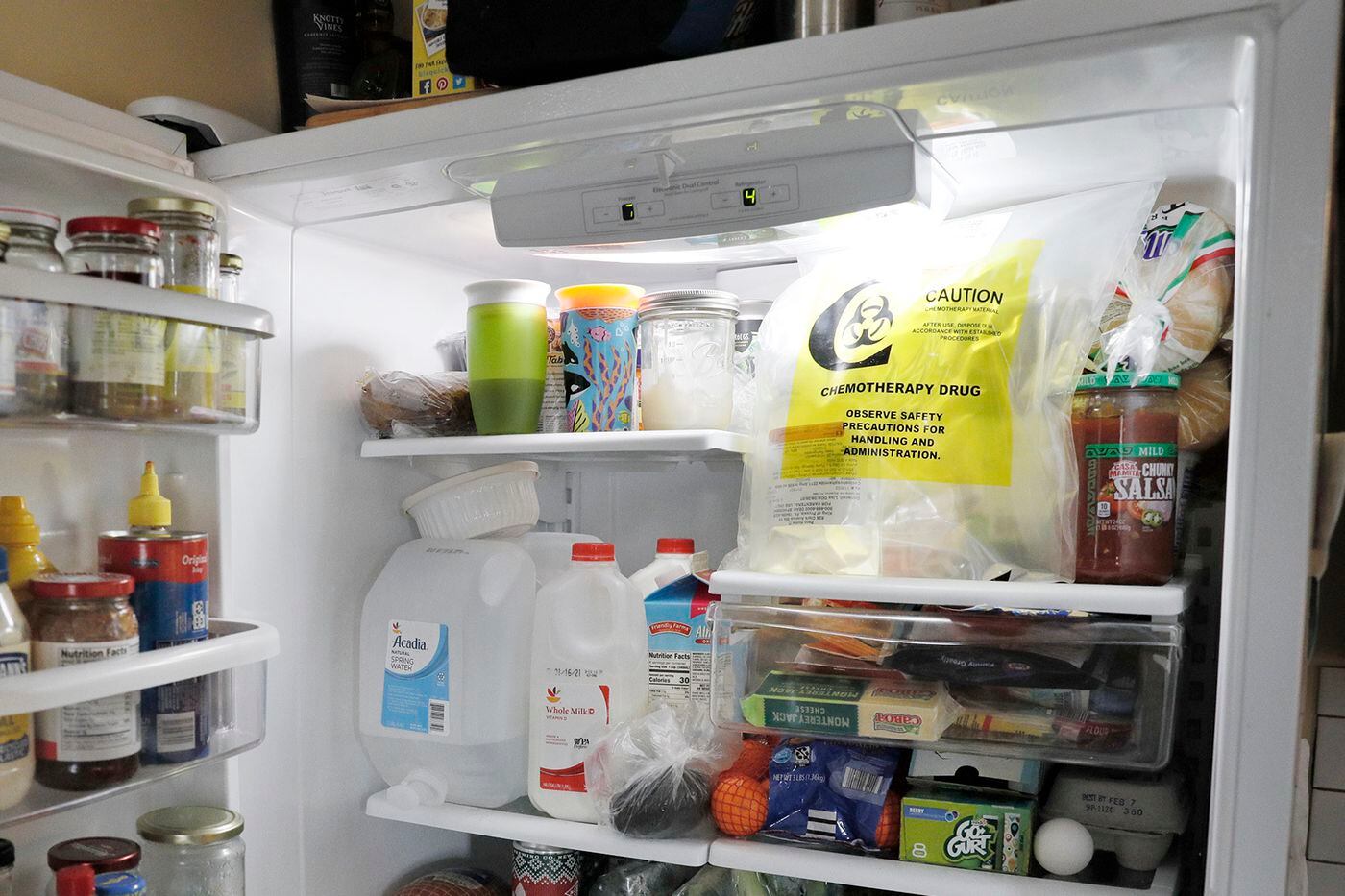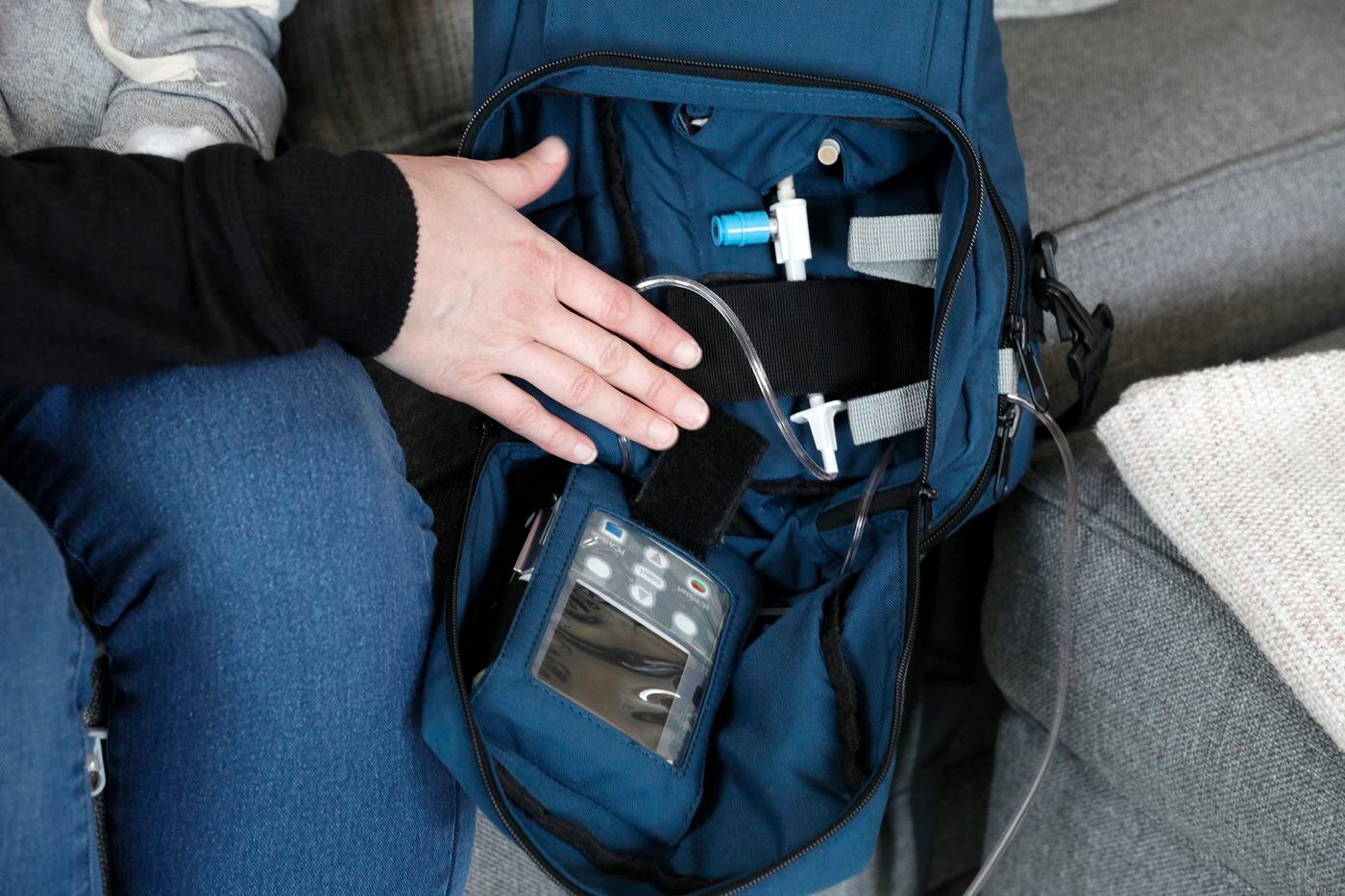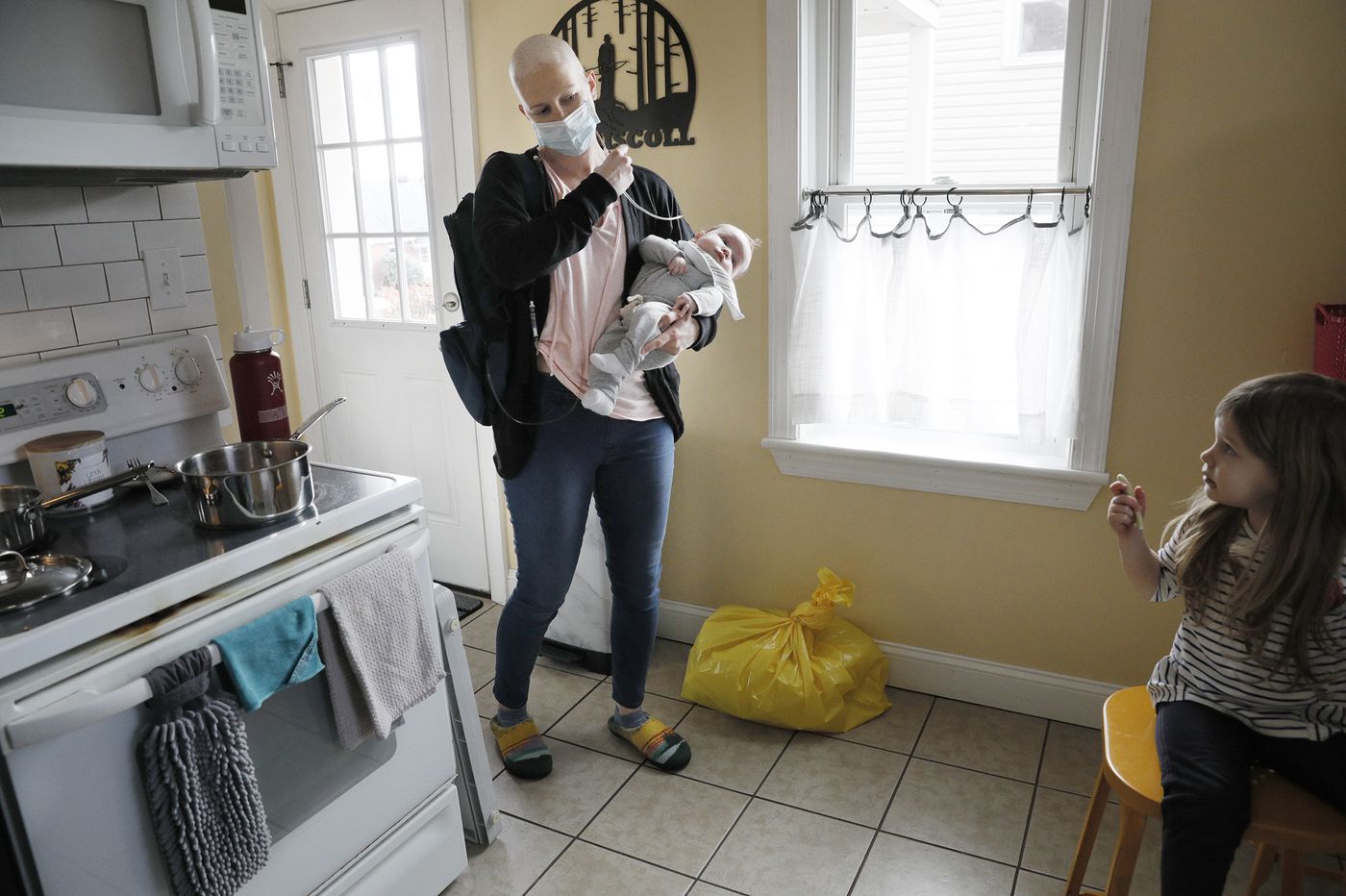Cancer treatment tackles a new frontier: Chemo at home, even on the go
As she fights cancer, Lisa Oney is not shackled to a hospital bed for days at a time, stuck there while she is infused with chemotherapy drugs.
She’s undergoing chemo at home — even on the move. At times, the life-saving medicine is flowing into her as she drives to make curbside pickups at Target.RELATED STORIES
- What cancer patients should know about the new COVID-19 vaccines
- Monoclonal antibodies can help high-risk people with COVID-19. But getting the drug to patients remains challenging.
- Can Biden pull off 100 million COVID-19 vaccinations in 100 days? Here are facts, data, and viewpoints.
Thanks to a new program at Penn Medicine, Oney, 33, carries her chemotherapy medicine in a backpack with a small pump that feeds the drug into her body. “I’m able to walk around, and take care of my kids,” she said. “I can go places.”
Typically, her particular regimen of chemotherapy would require several five-day stays in the hospital spread over 18 weeks. The trouble was, Oney needed to be home in Souderton to care for her 3-month-old son and 3-year-old daughter.
“I couldn’t do that,” she said, referring to the hospital visits. “My husband wouldn’t be able to work.”
Because of COVID-19, Oney and her husband, Kevin O’Driscoll, also can’t accept help from friends and coworkers. The risk of her catching the coronavirus or something else is too great.
Chemotherapy at home is a rising trend, driven by patient convenience and the widespread fear of hospitals during the pandemic. But as much as patients love it, antiquated health-care billing systems, especially in Medicare, remain a formidable obstacle to the practice.

Penn’s shift of some chemotherapy treatments to home started on a small scale before the pandemic, but then took off, according to Justin Bekelman, the radiation oncologist who directs the Penn Center for Cancer Care Innovation
Under the at-home process, Penn nurses drive to patients’ residences to set up the complex lines and do the injections involved in the cancer treatment, which in Oney’s case continues for days. After that, the backpack-wearing patients are free to go about their lives.
Bekelman said that Penn had good reasons to launch the effort. “It’s obviously patient-centric and will enhance patients’ experience of cancer treatment,” he said, “but also our infusion suites were all full up.”
Most experts see the move as positive for employers and taxpayers, who pay much of the cost of health care. Insurers pay less for patients who choose an at-home option as opposed to infusion at their main facility or even a specialist’s office.
Aetna, a major health insurer in the Philadelphia region, said last year that a single infusion of a specialty drug in a hospital, even on an outpatient basis, costs more than $20,000. The savings from moving it to an independent outpatient center can exceed 50%, it said. Home treatments save about the same, experts said.
But chemo in the home means much less money for hospitals, Bekelman noted, making it harder to expand the treatments.
“We need a payment model that keeps health-care providers whole irrespective of where we deliver the treatment,” he said. “That’s a crucial incentive for health systems to invest in providing more care at home and other less expensive locations — a shift that should ultimately save insurers money.”

A more logical payment system would promote changes such as in-home chemotherapy. And there has been some movement in that direction, said Larry Levitt, a health policy scholar at the Kaiser Family Foundation. One approach would be to uncouple insurance payments from specific procedures, he said.
“The concept is to pay providers a flat amount for certain patients or conditions,” Levitt said, “and let the providers figure out the best way to deliver care, keeping any savings they realize.”
He added: “The key is to build in safeguards to prevent providers from skimping on care.”
Not a new concept
Since at least the mid-1990s, home health care companies have talked about providing in-home chemotherapy, but little has come of it.
John Sprandio, an oncologist with offices in Delaware and Chester Counties, welcomes at-home chemotherapy, but cautions that it is actually more costly to provide than many realize.
“In terms of efficiency,” Sprandio said, “it’s obviously more cost-effective to administer these drugs for the majority of patients in a group setting where you have a team of a dozen nurses and 28 or 30 treatment areas that’s equipped to handle anything.”
Meanwhile, major trade associations such as the American Society of Clinical Oncology and the Community Oncology Alliance have formally opposed the practice. In statements last year, they cited a fear that patients might have a bad drug reaction with no doctors nearby.
Richard Snyder, chief medical officer for the parent company of Independent Blue Cross, said he was convinced that the trend was safe.
“Physicians and hospitals tend to be creatures of habit,” Snyder said. “We keep doing what seems to work for us, and so we’re not inclined to change our habit of giving the medication in a hospital or a higher-cost setting.”
Snyder described Penn as being at the forefront of moving chemotherapy to the home, where the patient is probably as safe as possible from exposure to COVID-19 and other infections.
Penn’s Cancer Care at Home program ramped up from 39 patients in March to more than 300 within a month as patients were eager to avoid hospitals. In all of last year, nearly 1,500 Penn patients received in-home chemo.
Currently, patients with breast cancer, prostate cancer and lymphoma are candidates for the program, Bekelman said. Penn hopes to add patients with lung cancer, head and neck cancers, and others, but that depends on higher reimbursements and other changes to insurance plans.
Bekelman said the goal wasn’t to transfer all cancer care, but to establish that it can be done safely off premises.
He noted that there were some limits because the risk of side effects was too severe with some chemo drugs.

Other Philadelphia-area providers of cancer care are not as active. Jefferson Health’s Sidney Kimmel Cancer Center has helped only 50 or so in-home patients in recent years. Fox Chase Cancer Center said it has no plans to join the trend. Nor does MD Anderson Cancer Center at Cooper hospital in Camden.
Nationally, CVS Health has joined Penn in trying to move more chemotherapy treatments to homes. This month, CVS, which owns Aetna, announced that its infusion unit, Coram, would work with Cancer Treatment Centers of America to do that, starting in Atlanta.
The insurance problem
Limiting wider adoption of in-home chemotherapy is a legacy payment system that provides much larger reimbursement when the treatments are done at a hospital.
Comparisons for such costs at different sites are hard to find. But a 2019 report showed that the average claim for an injection of infliximab, used to treat autoimmune diseases, was about $3,100 in a physician’s office, compared with $5,800 in a hospital’s outpatient department. Bekelman said that the same pattern holds for chemotherapy drugs and that reimbursement at home is similar to in a physician’s office.
Jefferson’s Sidney Kimmel Cancer Center has received widely varying reimbursement rates for home infusion. Some plans reimburse “on par with on-site infusion, while others reimburse at very low levels or not at all,” Karen E. Knudsen, a top oncology expert at Jefferson, said in an email.
Timothy Kubal, an oncologist who directs the infusion center at the Moffit Cancer Center in Tampa, Fla., predicted that much more cancer care could be provided in the home within a decade, “but in between now and then, there’s going to be a lot of conversation about what’s the right rate.”
The patient’s perspective
The bulk of the cancer patients Penn has been treating at home — instead of at an infusion center — are receiving injections for breast and prostate cancer. Penn Home Infusion nurses work around the patients’ schedules to they don’t have to lose time at jobs, Bekelman said.
Avoiding a hospital stay, as Oney, the patient from Souderton, is doing, is an even bigger deal during the pandemic.
“We have generally seen that being in the hospital can be tough, no family, food is different. Depression can set in, so overall I think this is a good trend if patients can manage at home,” said Kelly Harris, CEO of the nonprofit Cancer Support Community Greater Philadelphia.
Oney was diagnosed with lymphoma in November, just two weeks after her son was born. Before she began receiving steady treatment at home, she was given her first round of chemo in the hospital to ensure that she didn’t have an adverse reaction.
There was none. But on one later evening, Oney, a neonatal nurse at Grand View Hospital in upper Bucks County, got a headache as soon as the infusion started — possibly because she had forgotten to take the medication out of the refrigerator ahead of time.
Oney got a quick response from Penn’s on-call oncologist, who told her to take ibuprofen. “It’s all very connected,” she said.
Although being home doesn’t head off the miserable side effects of chemotherapy, she considers it a blessing to avoid those overnight hospital says.
I’m thankful to be home with my kids,” she said. “I couldn’t imagine not seeing them for five days every three weeks.”
Source: The Philadelphia Inquirer. By Harold Brubaker
Support families fighting financial toxicity of cancer here
